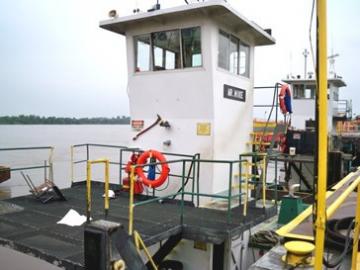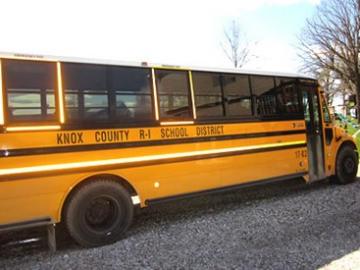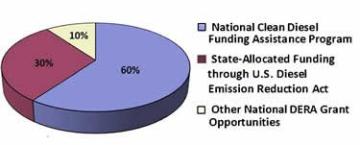Through the U.S. Diesel Emissions Reduction Act (DERA), Congress appropriates funds for projects to reduce diesel emissions from diesel fleets. Congress passed the Diesel Emissions Reduction Act (DERA) in 2005 as an amendment to the U.S. Energy Policy Act. EPA is responsible for overseeing and distributing funds authorized by this legislation. EPA has additional information about the federal DERA program on its website.
EPA splits the funds for reducing diesel emissions into different pools. Ninety percent of the funding goes toward state-allocated programs and the National Clean Diesel Funding Assistance Program. EPA uses the remaining ten percent to fund clean diesel programs at the national level, such as a ports initiative and the National School Bus Rebate and Retrofit Program.
The department is maximizing state DERA program by aligning it with the Volkswagen Trust. The department plans to match the state Diesel Emissions Reduction Act (DERA) grant with Volkswagen Trust funds, ensuring Missouri qualifies for the federal matching bonus.
State-Allocated Funding
EPA divides its state-allocated funding among the 50 states, Washington, D.C., and U.S. territories. The Missouri Department of Natural Resources' Air Pollution Control Program oversees distribution of Missouri's funding.
The department must use this federal funding for eligible clean diesel projects. Projects in Missouri have funded endeavors to cut emissions from trucks, school buses, locomotives, construction equipment and tug boats. Examples follow.
- Emission control retrofits (exhaust controls) are installed near tailpipes. The technology uses precious metals to oxidize certain pollutants and/or filters to trap pollutants. Recent technology relies on precious metals to oxidize pollutants and injections of ammonia into the exhaust stream to control NOx fumes.

- Idle reduction retrofits allow drivers to operate air conditioning, heaters, and/or small generators without running the engine. This technology cuts diesel emissions because drivers stay comfortable without having to idle their engines. Other efforts to reduce idling include electrified parking lots that enable truck drivers to operate climate control systems as well as technology that regulates locomotive engines so that they can stay warm without idling. Locomotive engines typically take a long time to warm up.
- SmartWay® technology includes idle reduction retrofits, as explained above, as well as more fuel efficient tires and aerodynamic retrofits, which help truck trailers reduce air resistance, improve fuel economy and reduce emissions. Manufacturers that offer this technology apply to the EPA's SmartWay® program to become certified. For more information visit SmartWay®.
- Some grants cover the cost difference between regular diesel and alternative fuels, such as biodiesel, natural gas, propane, and hydrogen fuel.
- Alternative fuel conversion kits enable diesel engines to run on alternative fuels, such as natural gas, propane, or hydrogen.
- Engine replacements require the removal of an existing engine to make room for a new or rebuilt engine verified by EPA to meet more stringent emission standards. The U.S. Diesel Emissions Reduction Act requires the old engine to be scrapped or returned to the original engine manufacturer to be retooled to a more stringent emission standard.
- Vehicle replacement programs help fleets buy new vehicles and take older vehicles out of service. The U.S. Diesel Emissions Reduction Act requires old vehicles to be permanently disabled to ensure emission reductions.
State-Allocated Clean Diesel Program
Past State-Allocated Clean Diesel Grants

- 2018 Missouri Clean Diesel Program - Funded early replacements of school buses
- 2017 Missouri Clean Diesel Program - Funded early replacements of school buses
- 2016 Missouri Clean Diesel Program - Funded early replacements of school buses
- 2015 Missouri Clean Diesel Program - Funded early replacements of school buses
- 2014 Missouri Clean Diesel Program - Replaced an engine in a tug boat in St. Louis
- 2013 Missouri Clean Diesel Program - Funded early replacements of school buses


